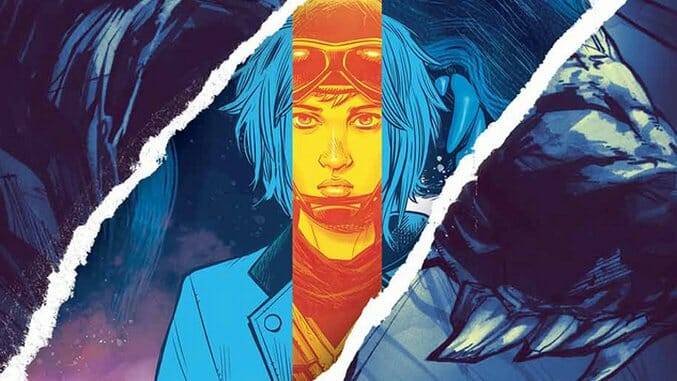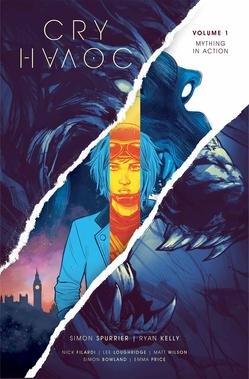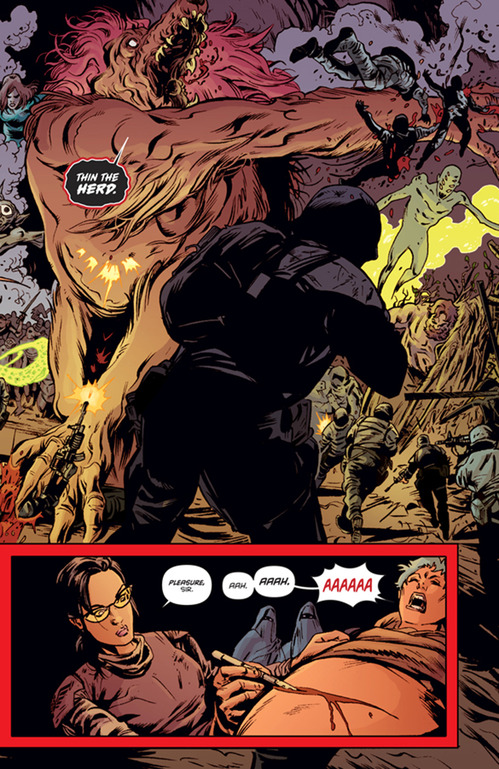Exit Interview: Simon Spurrier on Cry Havoc‘s Bloody Conclusion
Main Art by Ryan Kelly & Emma Price Comics Features
 Paste has paid a lot of attention to Cry Havoc: we chatted with writer Simon Spurrier before it launched, named it one of the best Image Comics currently being published and determined it to be one of the best books of 2016 (so far). In short: we think it’s pretty great.
Paste has paid a lot of attention to Cry Havoc: we chatted with writer Simon Spurrier before it launched, named it one of the best Image Comics currently being published and determined it to be one of the best books of 2016 (so far). In short: we think it’s pretty great.
The six-issue mindfuck, drawn by Ryan Kelly, designed by Emma Price and colored, per the book’s three simultaneous timelines, by Nick Filardi, Lee Loughridge and Matt Wilson, taps into deep-running themes of belief, power and personal destiny. Following last month’s concluding issue of Volume 1 and in advance of the complete trade paperback out later in August, Paste caught up with Spurrier to have a spoiler-filled discussion of protagonist Lou’s surprising arc, find out which nasty beasties didn’t quite make the cut and suss out what’s next for the book that isn’t about a lesbian werewolf going to war, but kind of is.
![]()
Paste: You’ve mentioned that any future Cry Havoc stories would be sequels, not necessarily picking up from the exact moment the final issue left off. If for whatever reason you’re unable to do more, do you feel content with the complete story told in this first volume?
Simon Spurrier: Yeah, absolutely.
I mean, it tacitly leaves things in a position where a whole new tale could—or, hey, must—emerge. But that’s often the case with stories about metamorphosis, isn’t it? Endings are inevitably New Beginnings, and “coming of age” is just a low-budget prequel for adulthood.
As an audience we may desperately want to know what happens to the butterfly after it goes fluttering off into the sunset—we might even have noticed there’s an ominous sparrow flittering around—but whatever that tale is, the story of the chrysalis is now over.
And of course you don’t get much more metamorphosis-y than a story about an accidental werewolf-cum-mercenary trying to work out who she really is. Vol. 1 of Cry Havoc answers that question in a pretty spectacular sort of way, and I couldn’t be prouder with how it’s turned out. Vol. 2—if-and-when it happens—will question how she applies that self-knowledge to the wider world. In, naturally, an even more spectacular sort of way.
But importantly, whether or not the sequel manifests, the first part is irreducible, unchangeable and ironclad.
(As storytellers we have to believe that. Otherwise nobody could ever watch Jaws without feeing tainted by the shitstink of Jaws 3-D lurking in the periphery of the mind. Human brains are very sophisticated about this sort of stuff.)
Quick preachy aside: this whole thing is a big problem for the medium of comics, whose financial sustainability—thanks to distribution models which mercilessly punish retailers—relies heavily on the predictability of cash flow. It’s a problem which has led directly to an industry-wide bias for narrative continuity rather than narrative satisfaction. That’s slowly starting to change, with publishers like Image now positioning ongoing series as a sequence of seasons, as with a TV show, rather than a perpetually elongated smear of unending (and hence unfocused) drama.
Paste: You said as much from the start, but Cry Havoc ended up not really being about werewolves after all, with ample time and spotlight given to other, lesser-known beasties. Between the core cast and Ryan’s detailed crowd shots, were there any mythical monsters you didn’t cover that you’re itching to use in future volumes?
Spurrier: Actually yes, a couple.
There are a few beasties I’d hoped to work into CH from the outset, but in the end didn’t have room to aim the spotlight. Some wound up among Ryan’s spectacular crowd scenes (which almost killed him, poor guy)—the “Kappa” springs to mind, which is a sort of turtle-ish water spirit from Japan with a fondness for cucumbers and a monomania about good manners. Others I deliberately omitted, with a view to putting them front-and-center in future seasons. Top of that particular list is the “Bufeo”, a river-dolphin from Bolivia (or “Encantado” in Brazil) which can shape-shift into a swarthy white-suited man with a tendency to crash parties and enchant unwary girls. He’s basically an appalling folkloric spin on a roofies-dropping dudebro with an added blowhole. Story-fodder par none.
I’m particularly interested in how all these splendid and creative bogeymen (and/or spirits, small gods, demons and avatars—all of which are frankly notches on the same wonderful bedpost) originated as conceptual technologies to guide people’s behaviour. “Stray near the water and the Kappa might get you,” “lower your guard around strange men at parties and you might end up as a dolphin’s toy,” etc. In many cases the pragmatism and interconnectedness of the modern world has rendered all these lovely Cautionary Tales obsolete, so I’m keen to explore ways of offering new relevance to redundant monsters. “Don’t touch women without permission, or the vengeful Rohypnol dolphin will come for you…”

Cry Havoc #6 Interior Art by Ryan Kelly & Lee Loughridge
Paste: You really upped the ante by introducing the Zeitgeist—we’re no longer just being asked to consider creatures made real, but abstract concepts given human form. There are shades there of both Neil Gaiman’s American Gods and Warren Ellis’ Century Babies from The Authority and Planetary. Do you view the Zeitgeist as unique in the Cry Havoc universe or might you approach other ideas/concepts given literalized form in future volumes?
Spurrier: I guess he’s unique in the sense that he’s the only entity in CH who hasn’t been sourced from recorded folklore, but then if you’re going to name an abstract concept “time-ghost”—those lovely Germans and their poetic portmanteaus—I suppose you’ve got to expect storytellers to take it literally. As you say, I’m far from the first writer to consider what a Distillation Of Today might look like. I just took it a step nastier by weaponising the poor sod.
Ultimately the Zeitgeist is no different from any other ghost, ghoul, bogey or boggart: all folk-monsters (and most gods) are simply useful focuses of abstract thought. He’s just a bit more on the Fundamental Cultural Concept scale than the rest.
Paste: Getting into spoiler territory, you leave Lou in a much different place than where we meet her—although the hints of her ascendency to alpha dog status are there from the first hyena scene. If there are indeed sequels, do you expect them to continue Lou’s story or pivot to other points of view?
Spurrier: A bit of both, per current plan. I’d like to slightly adjust the lens—bring in some other players in other corners of the world—to see how Lou’s new manifesto gradually bubbles into the light.
Frankly I’ve no shortage of ideas about how to approach it all, and I know exactly which characters I’d put center-stage, and where it’d end. Plenty of exciting storytelling experiments I want to pursue, too (à la the first book’s coloring games).
I’m afraid the if-ness and when-ness of it all hinges on thoroughly boring logistics: finding the time in mine and Ryan’s schedules, and being reasonably sure it’s financially viable. That’s not the answer you’re supposed to give in these cases, but there it is. Project-managing a creator-owned comic is a grotesquely difficult and stressful experience at the best of times, without the bigger team and humongous narrative complexity of a book like CH. One can’t just get stuck-in willy nilly. Vol. 1 was a labour of love in every meaning of the term, and speaking personally I think—as a technical exercise alone—it’s a pretty tasty WE’RE HERE YOU BASTARDS flag-plant from Ryan and me to the general C/O-readership.
But by nobody’s metric is it a strategically mainstream book. We’re increasingly living in a world where that needn’t be a problem, but still. We need to go spin some other plates for a spell, basically.

Cry Havoc #6 Interior Art by Ryan Kelly & Lee Loughridge
Paste: Now that the whole shebang is complete, how did working with colorists Nick Filardi, Lee Loughridge and Matt Wilson on different timelines within the same book change your perception of a colorist’s role in storytelling? I’ll admit the color differences became quite helpful in understanding scene transitions, especially as the plots picked up speed.
Spurrier: At risk of sounding like a smartarse: no big change in my own perception of a colorist’s role, simply because we wouldn’t have tried something as crazy as this if we didn’t a) need it and b) think it’d work.
I think this is probably true of every creator, but—speaking personally—I’ve known since the first comic I ever made that each member of a collaboration is not only a creative fount, but an overflowing box of storytelling tools to be used. The best comics occur when every member of the team is mercilessly exploiting every other.
So no, no personal surprise at how well that side of things turned out, but a loooot of pleasure in showing it off to the world. Colorists—like artists, inkers, letterers or designers—have the power to be utilised in thoroughly unexpected ways. If not for our trio of superstar hue-wranglers, CH would be a very different, significantly less clear and frankly far less good book.
Paste: You enlisted Emma Price to design the book and work with Ryan on covers. How did the three of you work together to define the book’s visual identity? I imagine that you have very limited contact—if any—with designers on your non-Image titles.
Spurrier: Yeah, the designer’s role—like the letterer’s—is horribly underappreciated. Bear in mind it’s only in the last few years the industry’s started waking up to accreditation for colorists, even. And I still see articles, interviews and project listings every day which refer to the writer as the “author” and ignore the artist altogether. In other words, the industry seems worryingly resistant to understanding just how collaborative the whole caboodle is.
Letterers, for instance, are criminally underrated. A good one can utterly transform how the reader’s eye moves across a page, not to mention having a critical impact on character voice-emphases. A bad one can ruin an otherwise excellent comic. We’ve been blessed to work with someone as professional, creative and experienced as Simon Bowland on CH.
As for Emma, having direct access to a designer, let alone one of her caliber, has been a revelation. She’s worked closely with Ryan to create those iconic main covers—it’s Ryan’s art with Emma’s color and arrangement—and the numbered templates for the variant cover series, not to mention all the logos and cover type, the interior design assets and all the backmatter. Her job is a curious blend of the visible and the invisible—the creative and the coordinated. I won’t pretend to claim it’s the same for every project, but in our case it’s been the designer who ultimately collates and uploads the pages to the publisher, and liaises with the production team at their end. I think the far more fitting term would be “art director,” frankly.
As with colorists, I think the industry is finally realising how important the role is. Emma’s skills have certainly been in demand since CH rolled out.

Cry Havoc #6 Interior Art by Ryan Kelly & Lee Loughridge
Paste: When we spoke before, you talked about Ryan’s skillful pacing and visual storytelling skills. Did his interpretation of your scripts surprise you at any point? Is there any particular sequence where he just blew away your expectations? I’m personally fond of the Penanggalan money shot in the final issue.
Spurrier: Nothing to add but more gushing, on that one. Ryan’s knocked it out of the park at every opportunity. Given how complex the story became (so many panels, so much weight to bear!), a lesser artist would’ve shit the proverbial bed a dozen times over. Instead Ryan has the priceless knack for not only arranging it all clearly and beautifully, but somehow creating the illusion of fluidity and simplicity in the process. Even the densest pages achieve the sort of millpond languidity you’d more commonly expect of a very decompressed book. That’s a talent rarer than hens’ teeth, in this game, and I can’t overstate how much of the story flows from Ryan’s innate sense of pace rather than anything I scripted.
The Penanggalan sequence is indeed an eye-opener, but I think my favorite scenes of his are the domestic moments with Lou and Sam at home. It’s a helluva penciller who can effortlessly endow panels with deep drama, irrespective of whether they feature a rampaging boar-monster tearing apart jihadists or a woman silently grating against her lover’s overbearing attentions.
Paste: Finally: What’s next for you? Is Cry Havoc Vol. 2 officially in the works? Do you have any upcoming projects you’d like to hint at now that both this and the Eisner-nominated The Spire (congrats) have come to a close?
Spurrier: I think we’ll be making a decision re: the timing of Cry Havoc Vol. 2 very soon. My sense of the current consensus is that we’ll definitely aim to get to it, but we both have to dot some other “i”s before we can invest the time and energy it deserves. CH Vol. 1 almost killed us both, and it isn’t the sort of act you can follow with a half-arsed encore, y’know? So, realistically, we’re probably looking at 2017 for that.
But, speaking personally, there’s a metric fuckton of really exciting other stuff coming down the metaphorical pipe.
I’ll be launching a new and oh-so-very-very different book through Image later this year (possibly an announcement at NYCC about that, if timings work out). I can’t say much more just now, but it’s a collaboration with one of my favorite young artists, in a genre I’ve always wanted to explore. Can’t wait for that. And there’s hopefully another creator-owned title lined up just behind and beside it, stars willing. With another of my favorite artists—a bona fide legend, actually—and my favorite project title ever.
Elsewhere, The Spire just wrapped up (thanks for the Eisner congrats, that book was such a personal project for Jeff [Stokely] and me it’s inexpressibly lovely to be recognized with a nom) and my hardboiled serial Weavers, also with BOOM! (“What if HP Lovecraft wrote a season of The Wire?”) is about halfway into its run, and doing very well. I have another pretty big thing coming down the mountain with BOOM!, which I’m not allowed to talk about yet. But, hoo-ee, it’s going to be amazing.
In WFH circles, I’ve now finished my run on the Garth Ennis/Alan Moore hybrid reality Crossed+100, which was as humbling as it was exceptionally difficult. I think the last few eps come out over the next couple months. I have another project on file with Avatar, which may be some of the best and/or most hellishly metafictional stuff I’ve ever written, and which will probably kill a string of artists along the way. I’ve just done a few hilariously fun bits and bobs with one of the Big 2, to keep my hand in there, and there are some far bigger projects I’m hoping to start in those circles soon. And last but not least I’m slowly approaching the end of my run on Doctor Who, co-written with my excellent colleague Rob Williams, and what a ride that’s been. Oh, and I have a new project coming out from the same publisher – Titan—which should send geeks of a particular age, particularly Brits, into an excitement-spiral. I think we announce that at SDCC.
And to top it all, I’ve just got home from my honeymoon, and am currently spending my first stint writing for TV.
To say 2016 has been bonkers would be an impressive understatement.
